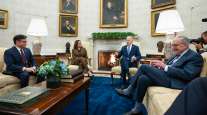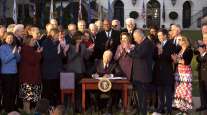Washington State Roads Are Getting Worse, New Data Shows

By several standards, the transportation network of Washington state is creaking under the pressures of age and economic growth.
Drivers traveled 6.4% more highway miles than two years ago and 4.8% farther overall. This increase fueled a 22% increase in urban delays due to congestion and added carbon pollutants that cause global warming.
Highway pavement is wearing out faster than the Washington State Department of Transportation (WSDOT) can maintain it.
Three Olympic-class vessels including the new Chimacum kept the ferry system afloat, but only 87.5% of statewide trips left on time this summer, missing the 95% goal. Parts of older ferries needed emergency repairs, leaving some routes with fewer boats, or smaller boats that took longer to load.
RELATED: How Washington DOT uses bombs, a Howitzer and an M60 tank to keep the roads open
And traffic killed 537 people last year, far above a goal set by safety advocates and a sign that Washington’s long-term gains have stalled.
These data appear in the third quarter 2017 WSDOT Gray Notebook, which mostly covers 2014-2016.
To be sure, the update contains good news.
Bridge maintenance is doing fine. Fewer than 10% qualified as poor, based on federal standards used by bridge inspectors.
Ferry-terminal conditions improved to 88% fair or good, as passenger lounges, trestles, pilings and gangways were renovated.
And WSDOT’s highway-incident teams cleared 58,235 fender-benders, objects and stalled cars within an average 13 minutes — a service that prevents untold numbers of secondary crashes.
Gov. Jay Inslee, his predecessor Christine Gregoire, and the Legislature have set lofty goals the state is currently failing to reach:
• A “Target Zero” program to eliminate traffic casualties by 2030.
To stay on pace, fatalities would need to be only 416, instead of the 537 lives lost in 2016.
Distracted driving is being blamed for reversing years of safety progress. A new law against using handheld devices behind the wheel took effect in July, but it’s routinely ignored. Seattle police and state troopers observed a grace period and will start issuing $136 fines in January.
• Greenhouse gases are supposed to be slashed to 1990 levels by 2020, and then reduced again by half by 2030.
Transportation causes 42% of the state’s carbon emissions. From 2010-13, which included the tail end of a recession, the state was on track. No longer.
“The economic growth in our region, combined with low gas prices and low unemployment, are the main reasons we’re continuing to see growth in vehicle miles traveled,” said WSDOT spokesman Lars Erickson.
“The transportation system has busted through the state’s emissions goals,” said Clark Williams-Derry, research director of Sightline Institute, a Seattle-based environmental research group.
Cheaper gasoline is a major factor, similar to national trends to drive farther and buy larger vehicles, he said.
Prices including tax fell 32% from $3.61 to $2.47 per gallon from 2014-16, the state report says.
Sightline supports a rapid shift to electric vehicles and carbon pricing through a use tax, highway tolls or other means.
“As long as we let people use the roadspace for free, and the atmosphere as a free dumping ground, we’re going to end up with more driving,” he said.
Lawmakers boosted gas taxes 11.9 cents in 2015-16, while dedicating $10.8 billion to road widening and maintenance. Urban voters passed the $54 billion Sound Transit plan to build rail and bus lines.
Inslee and WSDOT hope to increase electric vehicle numbers from 25,000 to 50,000 by 2020, by offering roadside charging stations and tax breaks.
“The governor would say we certainly haven’t done enough to reduce greenhouse gases and we should do more,” said spokeswoman Jaime Smith.
Among other moves, Inslee intends to invest up to $113 million in Volkswagen settlement funds in electric-car charging stations, electric buses and electric ferry technologies, Smith said. That amount is the state’s share of a federal settlement reached after VW admitted installing software on diesel cars to cheat emissions tests.
Electric technologies are the best solution to encourage a greener fleet, instead of “left-wing” proposals to tax motorists more, said Todd Myers, environmental analyst for the Washington Policy Center. “One mile traveled in a Hummer is very different from a mile in a Tesla,” he said.
Transit ridership increased 2% statewide. In dense, central Seattle, non-WSDOT data show that at least 47% of commuters ride transit. Bus, train and ferry ridership in the metro area rose 4% last year — while falling in nearly all other U.S. regions.
Amtrak Cascades suffered from record rain that caused mudslides, reducing on-time arrival to only 33% in February, March and April, and 56% for the year ending in June.
Later this month, a direct bypass track opens from Tacoma to DuPont, which should improve speed and reliability, compared to the old scenic but fickle trip around Point Defiance and The Narrows, mixed with freight trains.
As for road conditions, a longtime backlog of needed preservation work increased to $403 million in 2015.
Drivers can expect several weekend closures in 2018 to replace Interstate 5 concrete panels in Seattle — which were typically built in the 1960s — similar to this year’s summer of slowdowns in SeaTac and Tukwila.
Another trouble spot is Snoqualmie Pass, where motorists tapped their brakes for an hour or two all summer. Contractors fell behind their expected rate to fix Interstate 90 bridges, including the steel-arch bridge west of the summit, despite working past Labor Day. Erickson said they’ll strive to finish the whole corridor in 2018, starting well before Memorial Day.
Distributed by Tribune Content Agency, LLC




